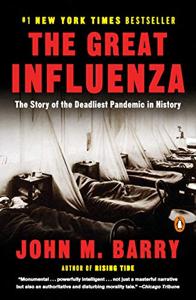
Want to learn the ideas in The Great Influenza better than ever? Read the world’s #1 book summary of The Great Influenza by John M. Barry here.
Read a brief 1-Page Summary or watch video summaries curated by our expert team. Note: this book guide is not affiliated with or endorsed by the publisher or author, and we always encourage you to purchase and read the full book.
Video Summaries of The Great Influenza
We’ve scoured the Internet for the very best videos on The Great Influenza, from high-quality videos summaries to interviews or commentary by John M. Barry.
1-Page Summary of The Great Influenza
Overall Summary
The Great Influenza: The Story of the Deadliest Pandemic in History is a nonfiction book by John M. Barry that examines the worst pandemic in world history, the influenza epidemic of 1918 and 1919. It follows American medical professionals as they try to combat this deadly disease, and it puts their story within a broader context by focusing on World War I, which exacerbated spread of the flu. The book was published in 2004 and has been republished several times since then. This guide uses information from 2018’s edition to examine how we can prevent another great flu pandemic like that one 100 years ago.
Barry first discusses the history of medicine. He argues that, until Johns Hopkins University was founded in 1876, American medical knowledge severely lagged behind European standards. Barry is especially interested in William Welch and Simon Flexner, who helped modernize American medical education by building laboratories and recruiting great scientists to train future generations of doctors. By doing this, they changed science forever.
In part 2, Barry explains that the virus originated in Haskell County, Kansas. It was spread to other parts of the country by soldiers from Haskell and then into Europe through American soldiers stationed there. He also explains how viruses work and what influenza is like. This section assumes that readers are not familiar with medical terminology or biological concepts so he uses analogies and metaphors to explain his point.
In Part 3, Barry discusses the reasons why America entered World War I in 1917. The government tried to censor all information that might hurt the war effort while also hiring Welch, Flexner and others to join the National Research Council to help prepare for a potential epidemic. Gorgas helped prepare the army for an outbreak of disease but he was more concerned with measles and pneumonia than influenza.
In Parts 4, 5 and 6, the author tells about how the influenza virus spread to become a worldwide pandemic in 1918. At first it was mild but then became deadly with nearly 300,000 Americans dying from it alone. Local leaders and newspapers either ignored the disease or misled people on its severity. However, scientists trained by Welch and Flexner worked hard to find a cure for this epidemic including Paul Lewis in Philadelphia and Oswald Avery in New York City. Nonetheless, they were unsuccessful as this virus continued to travel throughout the world causing havoc everywhere.
In part 7, Barry follows the scientists trying to develop a vaccine. He tells the stories of Avery, Lewis and Park in New York City by describing their lives and personalities. They each had different approaches and skill sets but they all contributed insights that eventually lead to vaccines. The vaccines were not successful though because viruses are still present today.
In parts 8 and 9, Barry traces the end of the pandemic as it entered a third and fourth wave. Each wave was less deadly than the previous one because researchers recognized that influenza was caused by a virus while at the same time mutations in the virus were rendering it less lethal. However, many people still suffered from complications related to influenza or lost loved ones to this disease. Additionally, Woodrow Wilson got sick with influenza while negotiating peace terms at Versailles after World War I ended, which changed history in some ways.
In the last part of the book, Barry follows Avery and Lewis as they continue their research on influenza. While Avery’s work is very successful, Lewis fails in his experiments and dies from yellow fever while working in Brazil.






